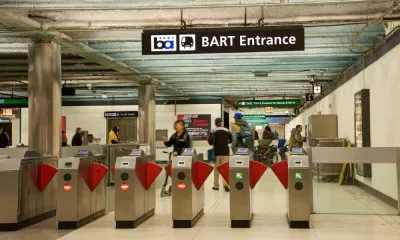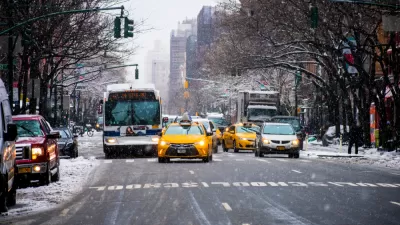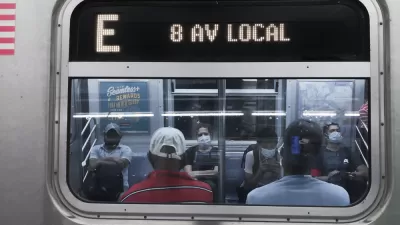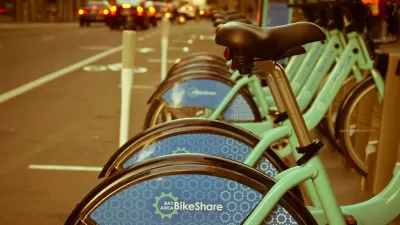San Francisco and New York exemplify the political challenges in finding long-term finding solutions for public transit in the post-pandemic United States.

“Across the country, transit agencies that depend heavily on fare revenues face a “fiscal cliff” in the near future when federal pandemic aid runs out,” according to an article by Daniel C. Vock for Route Fifty. “Ridership on these systems (and, therefore, fare revenues) have not returned to pre-pandemic levels.”
Citing the San Francisco and New York regions as the leading examples of transit systems struggling to make ends meet while facing a “fiscal cliff,” and seeking solutions that would generate more revenue for transit while charging more for the use of cars (a proposed bridge fee recently came up short in the legislature in California, while New York is continuing to face obstacles in implementing congestion pricing through a cordon system in Manhattan).
But both California and New York are trying other solutions to the transit fiscal cliff as well. “Lawmakers [in the state of New York] agreed to dedicate $1.1 billion a year from payroll taxes to help fund the MTA. They also promised a share of the licensing fees from an anticipated casino in the city, and added a one-time payment of $300 million.”
California’s solutions were less comprehensive, according to Vock: “transit advocates had to fight to avoid cuts in state support that [Gov.] Newsom originally proposed. The governor and lawmakers had to make up for a $32 billion anticipated deficit, about a 10th of the size of the state’s annual budget. Ultimately, lawmakers found $5 billion statewide through 2025 to stave off cuts to bus and rail service. But $4 billion of that is capital money that transit agencies can now use for operations.”
As noted by Planetizen coverage in recent years, the fiscal crisis facing public transit was only temporarily relieved by the massive federal stimulus bills approved since 2020, but the underlying issues facing transit persist in 2023. As noted by Vock, San Francisco and New York City are not the only cities facing the fiscal cliff brought about the pandemic.
Across the country, many other transit systems face similar financial predicaments. In the Washington, D.C., area, subway and bus operator WMATA faces an operating deficit of $750 million starting next summer. Transit agencies in the Chicago area warn that they will soon face a $730 million shortfall on their own. New Jersey Transit could see shortfalls of $1 billion.
More details can be found at the source article below, but public transit as we have known in the United States, even with the shortcomings inherent to co-existing in a car-centric planning era, is still at risk several years after Covid-19 arrived in North America.
FULL STORY: Transit agencies scramble to piece together funding as ‘fiscal cliff’ looms

Study: Maui’s Plan to Convert Vacation Rentals to Long-Term Housing Could Cause Nearly $1 Billion Economic Loss
The plan would reduce visitor accommodation by 25,% resulting in 1,900 jobs lost.

North Texas Transit Leaders Tout Benefits of TOD for Growing Region
At a summit focused on transit-oriented development, policymakers discussed how North Texas’ expanded light rail system can serve as a tool for economic growth.

Using Old Oil and Gas Wells for Green Energy Storage
Penn State researchers have found that repurposing abandoned oil and gas wells for geothermal-assisted compressed-air energy storage can boost efficiency, reduce environmental risks, and support clean energy and job transitions.

Santa Barbara Could Build Housing on County Land
County supervisors moved forward a proposal to build workforce housing on two county-owned parcels.

San Mateo Formally Opposes Freeway Project
The city council will send a letter to Caltrans urging the agency to reconsider a plan to expand the 101 through the city of San Mateo.

A Bronx Community Fights to Have its Voice Heard
After organizing and giving input for decades, the community around the Kingsbridge Armory might actually see it redeveloped — and they want to continue to have a say in how it goes.
Urban Design for Planners 1: Software Tools
This six-course series explores essential urban design concepts using open source software and equips planners with the tools they need to participate fully in the urban design process.
Planning for Universal Design
Learn the tools for implementing Universal Design in planning regulations.
Ascent Environmental
Borough of Carlisle
Institute for Housing and Urban Development Studies (IHS)
City of Grandview
Harvard GSD Executive Education
Toledo-Lucas County Plan Commissions
Salt Lake City
NYU Wagner Graduate School of Public Service





























